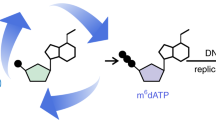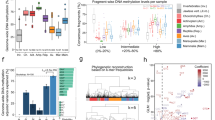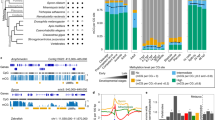Abstract
Methylation of cytosine deoxynucleotides generates 5-methylcytosine (m5dC), a well-established epigenetic mark. However, in higher eukaryotes much less is known about modifications affecting other deoxynucleotides. Here, we report the detection of N6-methyldeoxyadenosine (m6dA) in vertebrate DNA, specifically in Xenopus laevis but also in other species including mouse and human. Our methylome analysis reveals that m6dA is widely distributed across the eukaryotic genome and is present in different cell types but is commonly depleted from gene exons. Thus, direct DNA modifications might be more widespread than previously thought.
This is a preview of subscription content, access via your institution
Access options
Subscribe to this journal
Receive 12 print issues and online access
$189.00 per year
only $15.75 per issue
Buy this article
- Purchase on Springer Link
- Instant access to full article PDF
Prices may be subject to local taxes which are calculated during checkout





Similar content being viewed by others
Accession codes
References
Hotchkiss, R.D. The quantitative separation of purines, pyrimidines, and nucleosides by paper chromatography. J. Biol. Chem. 175, 315–332 (1948).
Gruenbaum, Y., Naveh-Many, T., Cedar, H. & Razin, A. Sequence specificity of methylation in higher plant DNA. Nature 292, 860–862 (1981).
Boyes, J. & Bird, A. DNA methylation inhibits transcription indirectly via a methyl-CpG binding protein. Cell 64, 1123–1134 (1991).
Jones, P.A. & Baylin, S.B. The fundamental role of epigenetic events in cancer. Nat. Rev. Genet. 3, 415–428 (2002).
Cantara, W.A. et al. The RNA Modification Database, RNAMDB: 2011 update. Nucleic Acids Res. 39, D195–D201 (2011).
Luria, S.E. & Human, M.L. A nonhereditary, host-induced variation of bacterial viruses. J. Bacteriol. 64, 557–569 (1952).
Bertani, G. & Weigle, J.J. Host controlled variation in bacterial viruses. J. Bacteriol. 65, 113–121 (1953).
Lu, M., Campbell, J.L., Boye, E. & Kleckner, N. SeqA: a negative modulator of replication initiation in E. coli. Cell 77, 413–426 (1994).
Laengle-Rouault, F., Maenhaut-Michel, G. & Radman, M. GATC sequence and mismatch repair in Escherichia coli. EMBO J. 5, 2009–2013 (1986).
Braaten, B.A., Nou, X., Kaltenbach, L.S. & Low, D.A. Methylation patterns in pap regulatory DNA control pyelonephritis-associated pili phase variation in E. coli. Cell 76, 577–588 (1994).
Roberts, D., Hoopes, B.C., McClure, W.R. & Kleckner, N. IS10 transposition is regulated by DNA adenine methylation. Cell 43, 117–130 (1985).
Kay, P.H. et al. Evidence for adenine methylation within the mouse myogenic gene Myo-D1. Gene 151, 89–95 (1994).
Reyes, E.M., Camacho-Arroyo, I., Nava, G. & Cerbón, M.A. Differential methylation in steroid 5 alpha-reductase isozyme genes in epididymis, testis, and liver of the adult rat. J. Androl. 18, 372–377 (1997).
Vanyushin, B.F., Tkacheva, S.G. & Belozersky, A.N. Rare bases in animal DNA. Nature 225, 948–949 (1970).
Lawley, P.D., Crathorn, A.R., Shah, S.A. & Smith, B.A. Biomethylation of deoxyribonucleic acid in cultured human tumour cells (HeLa): methylated bases other than 5-methylcytosine not detected. Biochem. J. 128, 133–138 (1972).
Gunthert, U., Schweiger, M., Stupp, M. & Doerfler, W. DNA methylation in adenovirus, adenovirus-transformed cells, and host cells. Proc. Natl. Acad. Sci. USA 73, 3923–3927 (1976).
Zhang, G. et al. N6-methyladenine DNA modification in Drosophila. Cell 161, 893–906 (2015).
Fu, Y. et al. N6-methyldeoxyadenosine marks active transcription start sites in chlamydomonas. Cell 161, 879–892 (2015).
Greer, E.L. et al. DNA methylation on N6-adenine in C. elegans. Cell 161, 868–878 (2015).
Munns, T.W., Liszewski, M.K. & Sims, H.F. Characterization of antibodies specific for N6-methyladenosine and for 7-methylguanosine. Biochemistry 16, 2163–2168 (1977).
Marinus, M.G. & Morris, N.R. Isolation of deoxyribonucleic acid methylase mutants of Escherichia coli K-12. J. Bacteriol. 114, 1143–1150 (1973).
May, M.S. & Hattman, S. Analysis of bacteriophage deoxyribonucleic acid sequences methylated by host- and R-factor-controlled enzymes. J. Bacteriol. 123, 768–770 (1975).
Kobayashi, H. et al. Contribution of intragenic DNA methylation in mouse gametic DNA methylomes to establish oocyte-specific heritable marks. PLoS Genet. 8, e1002440 (2012).
Pollard, K.S., Hubisz, M.J., Rosenbloom, K.R. & Siepel, A. Detection of nonneutral substitution rates on mammalian phylogenies. Genome Res. 20, 110–121 (2010).
Geier, G.E. & Modrich, P. Recognition sequence of the dam methylase of Escherichia coli K12 and mode of cleavage of Dpn I endonuclease. J. Biol. Chem. 254, 1408–1413 (1979).
Bailey, T.L. & Elkan, C. Fitting a mixture model by expectation maximization to discover motifs in biopolymers. Proc. Int. Conf. Intell. Syst. Mol. Biol. 2, 28–36 (1994).
Ito, S. et al. Tet proteins can convert 5-methylcytosine to 5-formylcytosine and 5-carboxylcytosine. Science 333, 1300–1303 (2011).
Pfaffeneder, T. et al. The discovery of 5-formylcytosine in embryonic stem cell DNA. Angew. Chem. Int. Edn Engl. 50, 7008–7012 (2011).
Dominissini, D., Moshitch-Moshkovitz, S., Salmon-Divon, M., Amariglio, N. & Rechavi, G. Transcriptome-wide mapping of N6-methyladenosine by m6A-seq based on immunocapturing and massively parallel sequencing. Nat. Protoc. 8, 176–189 (2013).
Ford, E., Nikopoulou, C., Kokkalis, A. & Thanos, D. A method for generating highly multiplexed ChIP-seq libraries. BMC Res. Notes 7, 312 (2014).
Li, H. & Durbin, R. Fast and accurate short read alignment with Burrows-Wheeler transform. Bioinformatics 25, 1754–1760 (2009).
Bowes, J.B. et al. Xenbase: a Xenopus biology and genomics resource. Nucleic Acids Res. 36, D761–D767 (2008).
Kent, W.J. et al. The human genome browser at UCSC. Genome Res. 12, 996–1006 (2002).
Zdobnov, E.M. & Apweiler, R. InterProScan: an integration platform for the signature-recognition methods in InterPro. Bioinformatics 17, 847–848 (2001).
Thomas, P.D. et al. PANTHER: a library of protein families and subfamilies indexed by function. Genome Res. 13, 2129–2141 (2003).
Zang, C. et al. A clustering approach for identification of enriched domains from histone modification ChIP-Seq data. Bioinformatics 25, 1952–1958 (2009).
Morgulis, A., Gertz, E.M., Schäffer, A.A. & Agarwala, R. A fast and symmetric DUST implementation to mask low-complexity DNA sequences. J. Comput. Biol. 13, 1028–1040 (2006).
Lawrence, M. et al. Software for computing and annotating genomic ranges. PLoS Comput. Biol. 9, e1003118 (2013).
Micallef, L. & Rodgers, P. eulerAPE: drawing area-proportional 3-Venn diagrams using ellipses. PLoS One 9, e101717 (2014).
Acknowledgements
M.J.K. was supported by a Long-Term Human Frontiers Fellowship (LT000149/2010-l), a Medical Research Council (MRC) grant (G1001690) and an Isaac Newton Trust Fellowship (RG76588). This work was sponsored by a Biotechnology and Biological Sciences Research Council grant (BB/M022994/1 to J.B.G. and M.J.K.). The laboratory of J.B.G. is funded by Wellcome Trust grant 101050/Z/13/Z (J.B.G.) and is supported by Gurdon Institute core grants, namely a Wellcome Trust Core Grant (092096/Z/10/Z) and a Cancer Research UK grant (C6946/A14492). C.R.B. and G.E.A. are funded by a Wellcome Trust Core Grant (092096/Z/10/Z). A.S.H.C. and C.F. are funded by the MRC Cancer Unit core grant. We are grateful to D. Simpson and R. Jones-Green for preparing X. laevis eggs and oocytes, F. Miller for providing us with M. musculus tissue, T. Dyl for X. laevis eggs and D. rerio samples (all researchers from Gurdon Institute, University of Cambridge), and members of J.B.G.'s laboratory for their critical comments. We thank U. Ruether (Entwicklungs- und Molekularbiologie der Tiere, Heinrich Heine Universitaet Duesseldorf) for providing us with M. musculus kidney DNA. We also thank J. Ahringer, S. Jackson, A. Bannister and T. Kouzarides (Gurdon Institute, University of Cambridge) for critical input and advice, and M. Sciacovelli and E. Gaude (MRC Cancer Unit, University of Cambridge) for suggestions.
Author information
Authors and Affiliations
Contributions
A.S.H.C. performed all UHPLC-MS/MS analyses. M.J.K. conceived the study, designed and performed all experiments, analyzed the data, supervised all research and wrote the paper. C.R.B. and G.E.A. performed the bioinformatic analyses, developed ideas and helped to generate figures and to write the paper. C.F. advised on and supervised all UHPLC-MS/MS analyses, and both A.S.H.C. and C.F. helped to design UHPLC-MS/MS studies and to write the paper. J.B.G. assisted with writing the paper and supervised all research.
Corresponding author
Ethics declarations
Competing interests
The authors declare no competing financial interests.
Integrated supplementary information
Supplementary Figure 1 m6dA Ab recognition of DNA oligonucleotides and X. laevis sperm DNA.
a, m6dA Ab dot blot. Dot blot with different amounts of synthetic DNA oligos and m6dA Ab staining. b, Quantification of the m6dA dot blot. Error bars, s.e.m., n=3 technical replicates, *P<0.04, two-sided t-test, AU = arbitrary units. c, m6dA Ab DIP with synthetic DNA oligos. Error bars, s.e.m., n=3 technical replicates, **P<2×10−3, two-sided t-test, AU = arbitrary units. d, Enrichment of X. laevis sperm DNA fragments using m6dA Ab DIP. e, Quantification of the m6dA Ab DIP. Error bars, s.e.m., n=3 technical replicates, **P<5×10−5, two-sided test, AU = arbitrary units. f, X. laevis sperm DNA dot blot in the presence of competitor-antibody solution. As competitors, dA, dC or m5dC and m6dA were used. g, Quantification of the blot exposed to competitor-antibody solution. The level of the m6dA signal shown. Competitors such as m6dA (red), dA (light grey), dC (dark grey) and m5dC (black) are indicated. Error bars, s.e.m., n=9 technical replicates, **P<4×10−17, two-sided t-test. h, DNA recovery after m6dA Ab DIP. Different amounts fragmented sperm DNA were subject to m6dA Ab DIP. Error bars, s.e.m., n=3 technical replicates, **P<0.003, two-sided t-test.
Supplementary Figure 2 Detection of methylated deoxyadenosine by UHPLC-MS/MS.
a, Fragmentation pathway of m6dA. b, Representative calibration curve (1 out of 4). c, UHPLC-MS/MS EIC chromatogram of m6dA (left) and fragmentation spectrum (right) of representative (1 out of 4) synthetic standard (0.1μM). * Indicates parent ion, n=4 technical replicates, AU = arbitrary units. d, UHPLC-MS/MS EIC chromatogram (left) and fragmentation spectrum (right) of representative (1 out of 4) water control processed without m6dA Ab DIP. n=4 water from different sources, AU = arbitrary units. e, UHPLC-MS/MS EIC chromatogram (left) and fragmentation spectrum (right) of representative (1 out of 4) water control processed following m6dA Ab DIP. Only a spurious m6dA signal is detected. * Indicates parent ion, n=4 water from different sources, AU = arbitrary units. f-g, UHPLC-MS/MS EIC chromatogram (left) and fragmentation spectrum (right) of representative (1 out of 4) genomic DNA from Dam+ and Dam– bacteria isolated following m6dA Ab DIP. * Indicates parent ion, n=4 bacteria from different cultures, AU = arbitrary units.
Supplementary Figure 3 Distribution of m6dA in the genome in X. laevis and M. musculus.
a, Distribution of m6dA peaks around TSS, from 20kb 5’ to 20kb 3’, identified in X. laevis fat, oviduct, testes and in M. musculus kidney. One biological replicate from one animal is shown in each graph. b-e, Density of m6dA versus unmethylated dA in distinct areas of the genome of X. laevis and M. musculus. Only the regions shown in dark grey are statistically significant. One biological replicate from one animal is shown in each graph, **P<0.005, *P<0.05, binomial test on m6dA peaks.
Supplementary Figure 4 Genome-wide distribution of m6dA in the vicinity of genes, on the basis of comparisons of m6dA Ab* and m6dA Ab** DIP-seq versus input-seq or IgG-seq.
a, Distribution of m6dA peaks around TSS, from 20kb 5’ to 20kb 3’, identified in X. laevis testes. The m6dA peaks were obtained from m6dA Ab* and m6dA Ab** DIP-seq versus input-seq or IgG-seq controls. One biological replicate from one animal is shown in each graph. b, Density of m6dA versus unmethylated dA in distinct areas of the genome of X. laevis testes. The m6dA peaks were obtained from m6dA Ab* and m6dA Ab** DIP-seq versus input-seq or IgG-seq controls. Only the regions shown in dark grey are statistically significant. One biological replicate from one animal is shown in each graph, **P<0.005, *P<0.05, binomial test on m6dA peaks.
Supplementary Figure 5 m6dA motifs identified in X. laevis from shifted m6dA peaks.
MEME motifs on shifted X. laevis m6dA peaks. Overlaps between biological replicates from different animals were used for analysis. Same tissue n=2 biological replicates from different animals, different tissue overlaps n=6 biological replicates for different animals, E-value < 1.2×10−8, statistics by MEME, AU = arbitrary units.
Supplementary information
Supplementary Text and Figures
Supplementary Figures 1–5 and Supplementary Tables 1, 3 and 4 (PDF 1211 kb)
Supplementary Data Set 1
Uncropped images for dot blots shown in Figure 1b,g (PDF 93 kb)
Supplementary Table 2
Dataset of all m6dA peaks identified by comparing m6dA Ab DIP-seq with input-seq samples from X. laevis and M. musculus biological replicates (XLSX 16237 kb)
Supplementary Table 5
Data set of all m6dA peaks identified by comparing m6dA Ab DIP-seq, m6dA Ab* DIP-seq, m6dA Ab** DIP-seq with input-seq and IgG-seq samples from X. laevis testis biological replicates (XLSX 15638 kb)
Supplementary Table 6
Data set of all m6dA peaks identified in Dam+ and Dam– E. coli (XLSX 260 kb)
Supplementary Table 7
Data set of enrichment values found in X. laevis m6dA peaks for all 256 4bp motifs (XLSX 110 kb)
Rights and permissions
About this article
Cite this article
Koziol, M., Bradshaw, C., Allen, G. et al. Identification of methylated deoxyadenosines in vertebrates reveals diversity in DNA modifications. Nat Struct Mol Biol 23, 24–30 (2016). https://doi.org/10.1038/nsmb.3145
Received:
Accepted:
Published:
Issue Date:
DOI: https://doi.org/10.1038/nsmb.3145
This article is cited by
-
Genome-wide deposition of 6-methyladenine in human DNA reduces the viability of HEK293 cells and directly influences gene expression
Communications Biology (2023)
-
A novel N6-Deoxyadenine methyltransferase METL-9 modulates C. elegans immunity via dichotomous mechanisms
Cell Research (2023)
-
Context-dependent DNA polymerization effects can masquerade as DNA modification signals
BMC Genomics (2022)
-
Rare and misincorporated DNA N6-methyladenine is a hallmark of cytotoxic stresses for selectively stimulating the stemness and proliferation of glioblastoma cells
Cell Discovery (2022)
-
DNA and histone modifications as potent diagnostic and therapeutic targets to advance non-small cell lung cancer management from the perspective of 3P medicine
EPMA Journal (2022)



